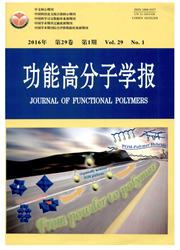

 中文摘要:
中文摘要:
分别以钛酸正丁酯(C16H36O4Ti)、醋酸(CH3COOH)、盐酸(HCl)、丙基三甲氧基硅烷(KH560)、苯基三甲氧基硅烷(Ph-TMS)、甲醇(CH3OH)和去离子水为原料,氨水(NH3·H2O)为催化剂,采用溶胶-凝胶法和复合溶胶-凝胶法分别涂覆制备防老化聚亚苯基苯并二噁唑(PBO)纤维。通过粒度分析验证了纳米溶胶的成功制备,通过EDS能谱、SEM扫描电镜、接触角测定等手段分析测试PBO纤维表面的化学组成与物理性能,验证防老化PBO纤维的制备。以拉伸强度测试、SEM扫描电镜和表面接触角表征PBO纤维的防老化性能。结果表明:在氙灯耐气候试验箱经历130 h的老化后,与未经过涂覆的PBO原纤相比,采用纳米TiO2水溶胶-凝胶法涂覆的PBO纤维拉伸强度保持率只提高了5%,利用纳米有机硅溶胶-凝胶法涂覆的PBO纤维拉伸强度保持率可提高10%,而经过纳米TiO2和有机硅复合溶胶-凝胶法涂覆的PBO纤维,拉伸强度保持率提高了27%,且老化后的纤维表面保持得非常完整。
 英文摘要:
英文摘要:
Individually using C16H36O4Ti, CH3COOH, HCl, C9H20O5Si (KH560), C9H14O3Si (Ph-TMS), CH3OH and deionized water as raw material, NH3·H2O as catalyst, anti-photoaging poly (p-phenylene-2,6-benzobisoxazole) (PBO) fibers were prepared by sol-gel method and multiple sol-gel method, respectively. The particle size analyses were done to verify the successful preparation of two kinds of nano-sol. The chemical composition and the physical properties of the surface of PBO fibers were characterized by EDS, SEM, particle size determination and contact angle test to verify the preparation of anti-photoaging PBO fibers. The anti-photoaging property of PBO fibers were characterized by SEM, tensile strength and contact angle test. Results show that after photoaging for 130 h, the tensile strength retention rate of PBO fibers individually coated by nano-TiO2 hydrosol-gel method and nano-organo-silicon sol-gel method are just 5% and 10% higher than the uncoated PBO fiber, respectively. Whereas after aging for 130 h, the tensile strength retention rate of PBO fiber successively coated by nano-TiO2 hydrosol-gel method and nano-organo-silicon sol-gel method is 27% higher than the uncoated PBO fiber, and the surface of the fiber is still complete.
 同期刊论文项目
同期刊论文项目
 同项目期刊论文
同项目期刊论文
 Effect of Heat Treatment on Properties and Structural Changes of Poly(p-Phenylene Benzobisoxazole) F
Effect of Heat Treatment on Properties and Structural Changes of Poly(p-Phenylene Benzobisoxazole) F In situ synthesis and characterization of poly(2,5-benzoxazole)/multiwalled carbon nanotubes composi
In situ synthesis and characterization of poly(2,5-benzoxazole)/multiwalled carbon nanotubes composi Molecular Simulation of Miscibility of Poly(2,6-dimethyl-1,4-phenylene ether)/ Poly(styrene-co-acryl
Molecular Simulation of Miscibility of Poly(2,6-dimethyl-1,4-phenylene ether)/ Poly(styrene-co-acryl Synthesis of acid-soluble graphene and its use in producing a reduced graphene oxide/poly(benzobisox
Synthesis of acid-soluble graphene and its use in producing a reduced graphene oxide/poly(benzobisox 期刊信息
期刊信息
